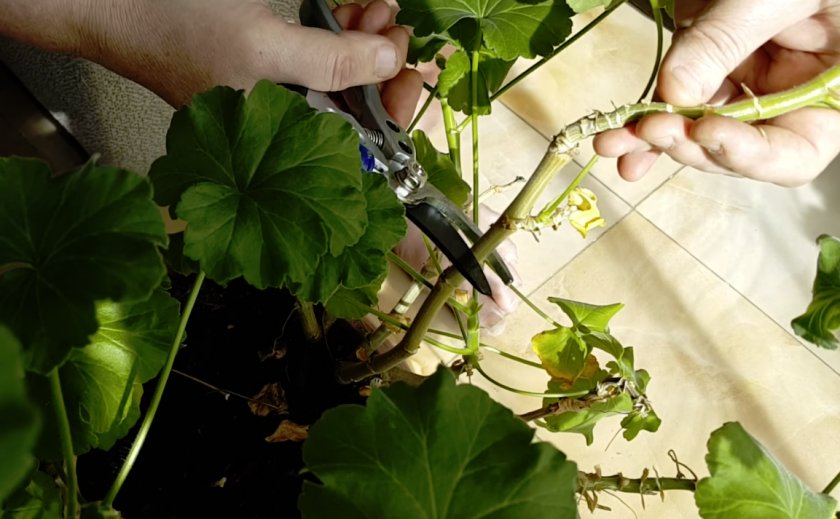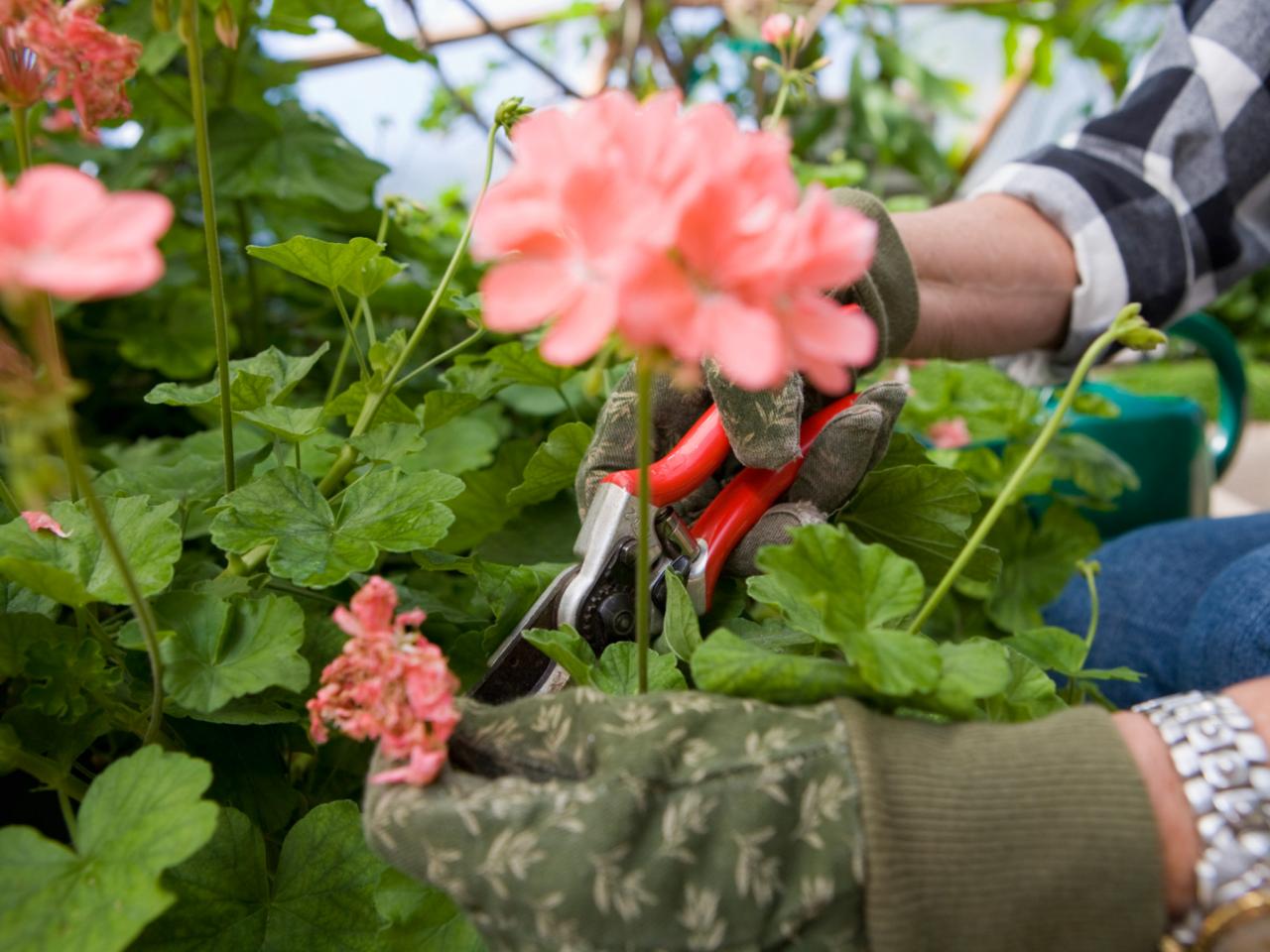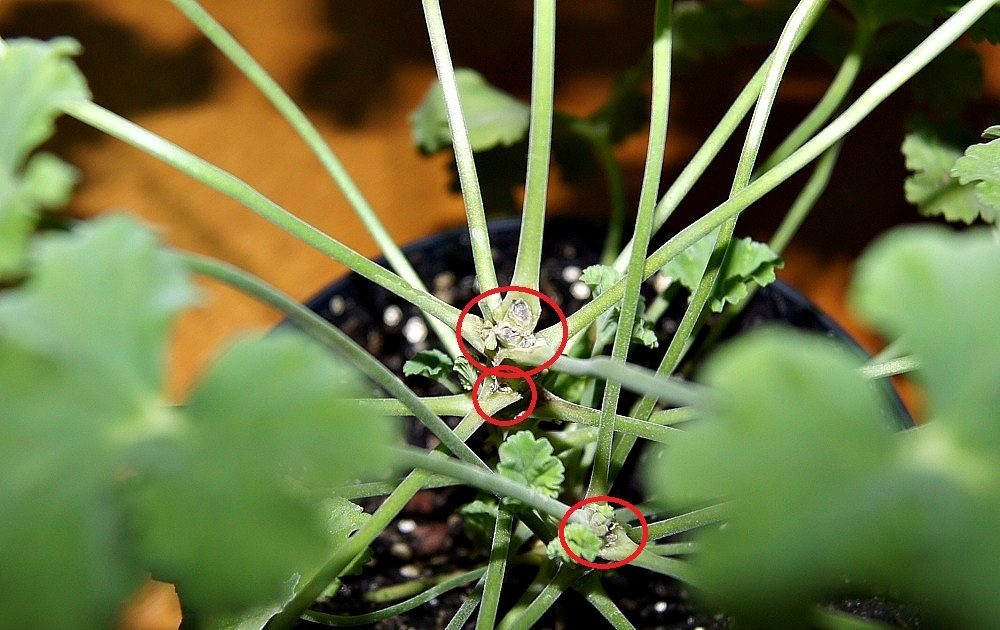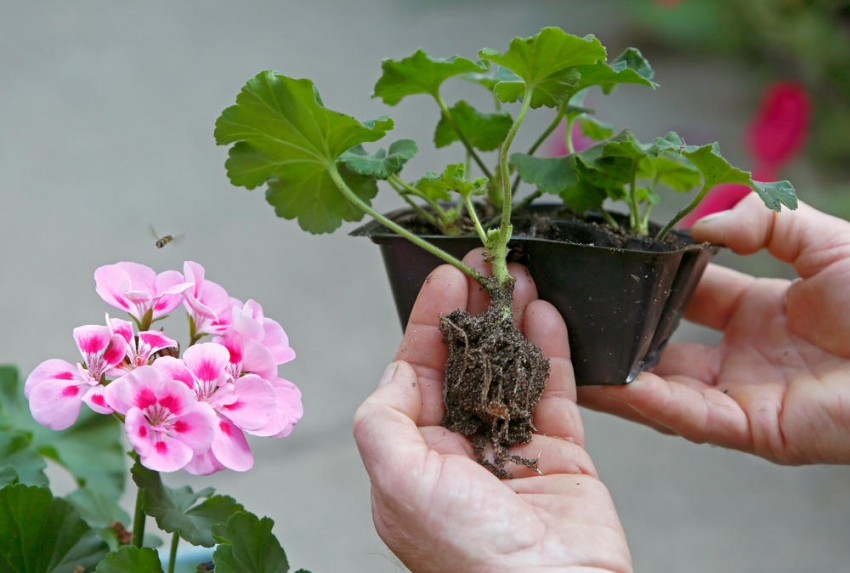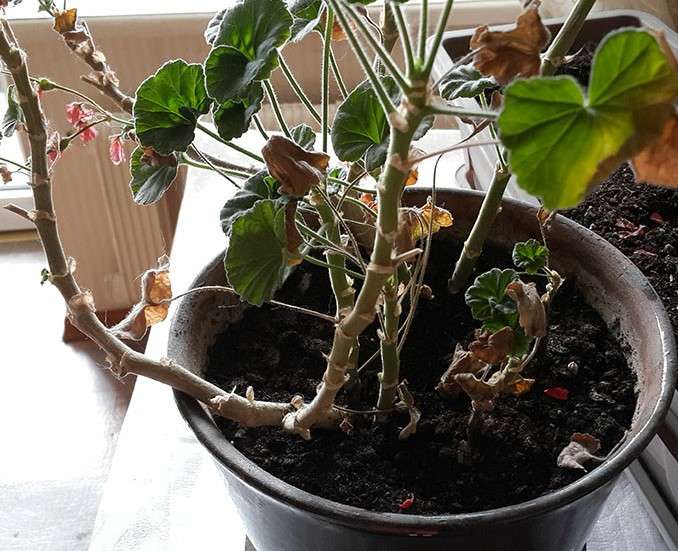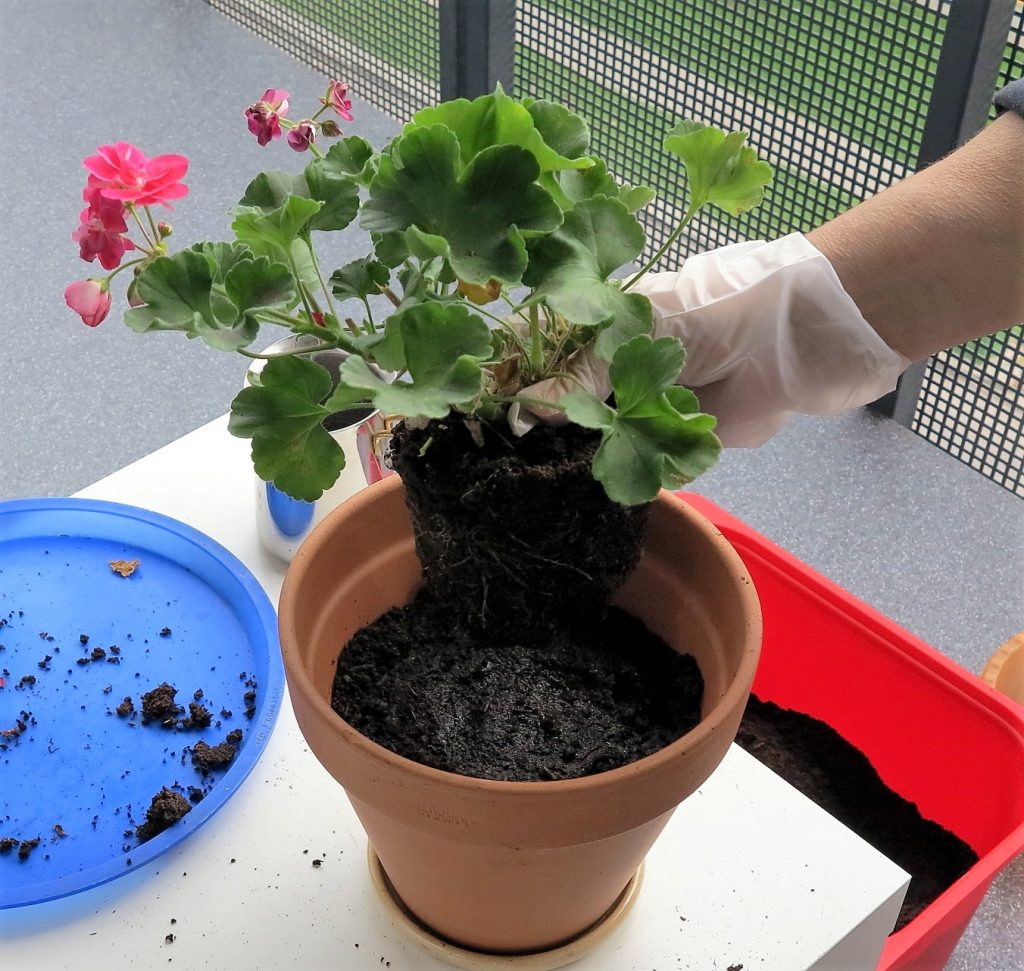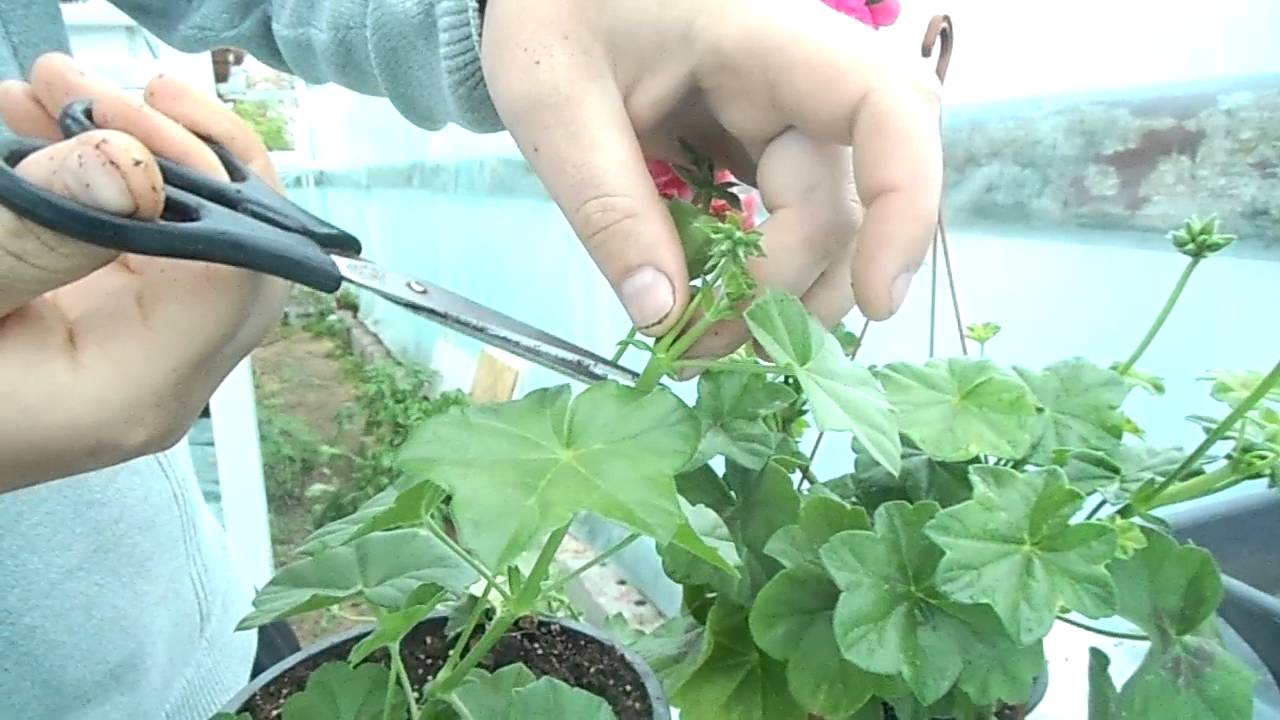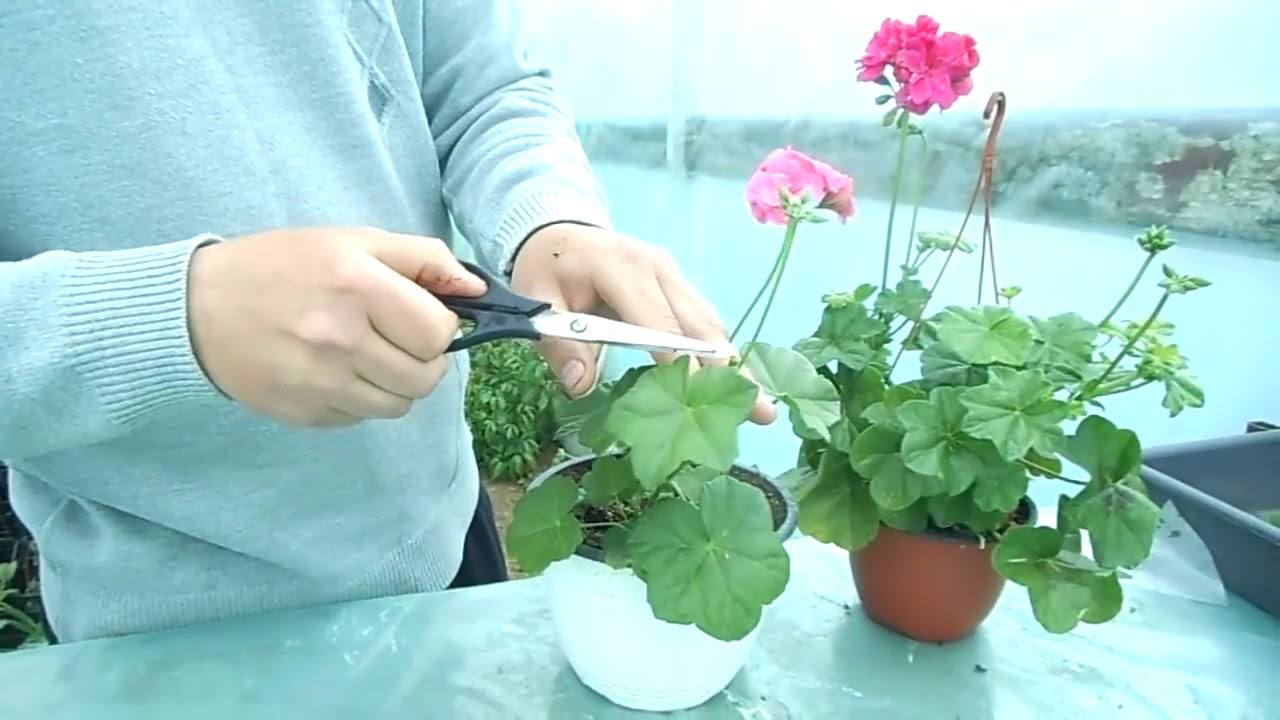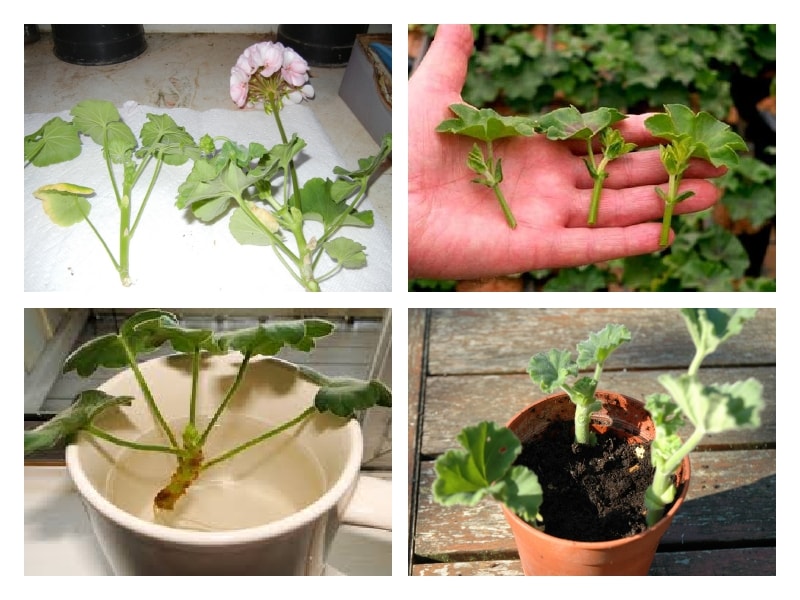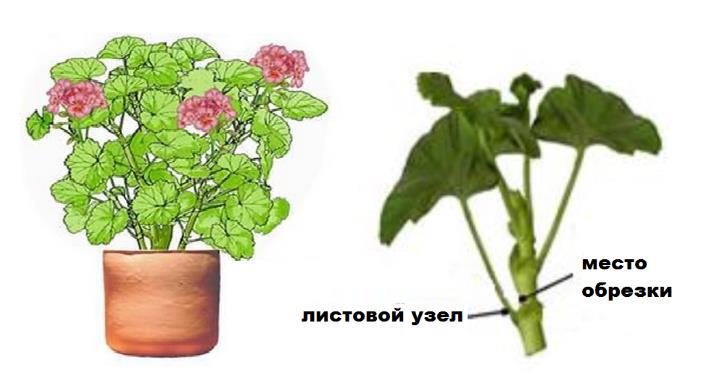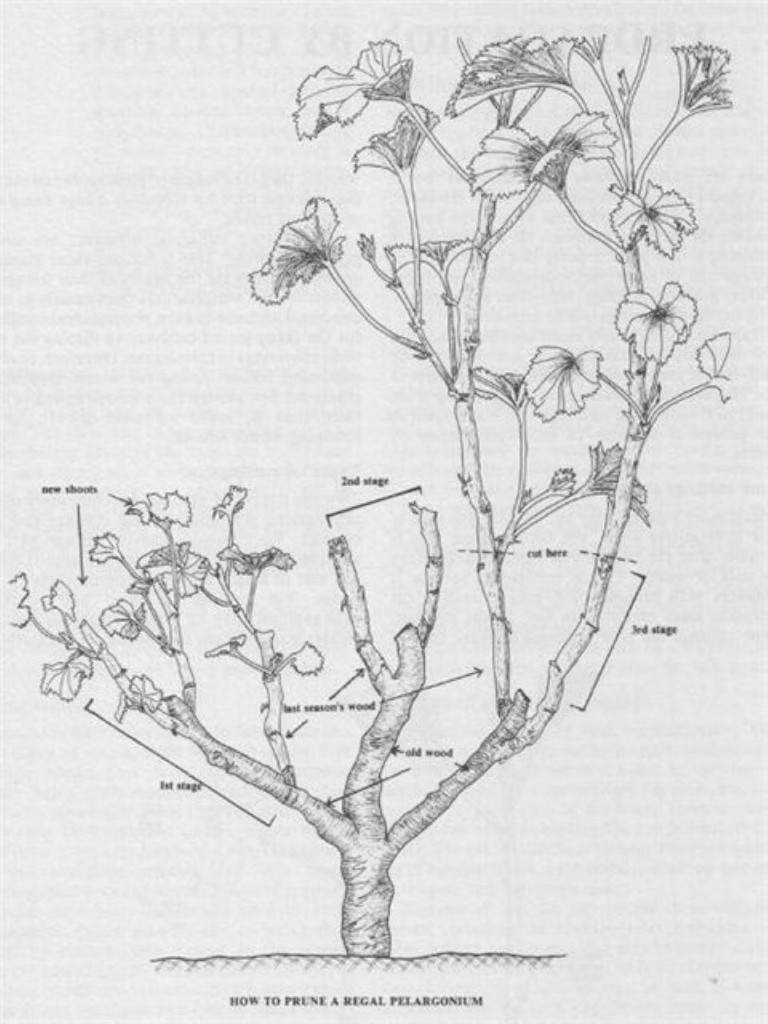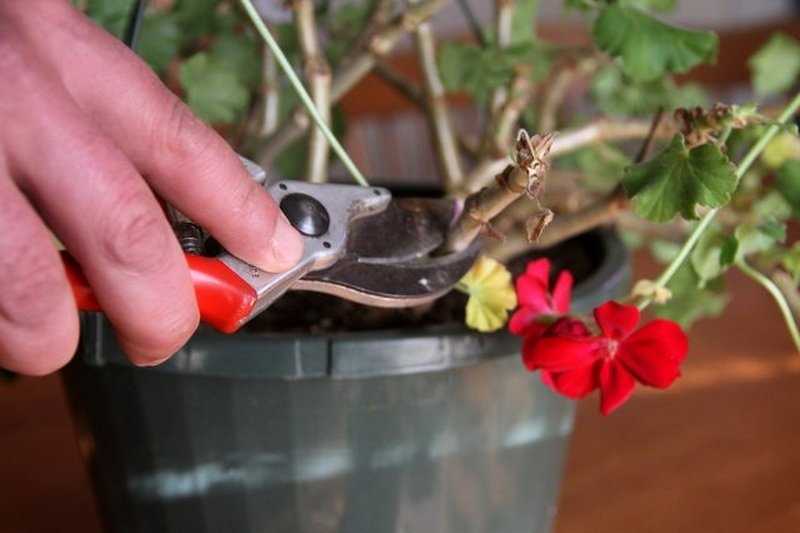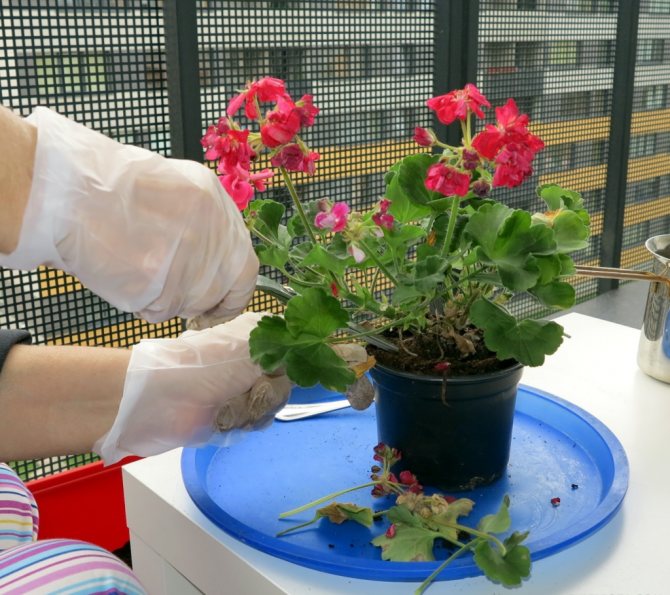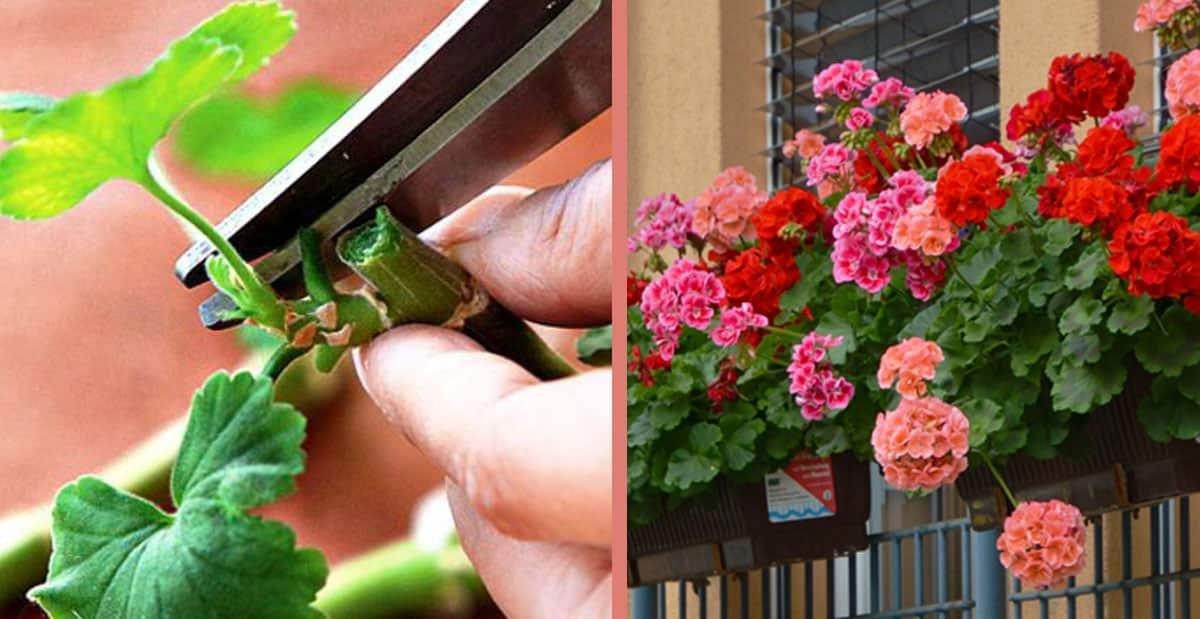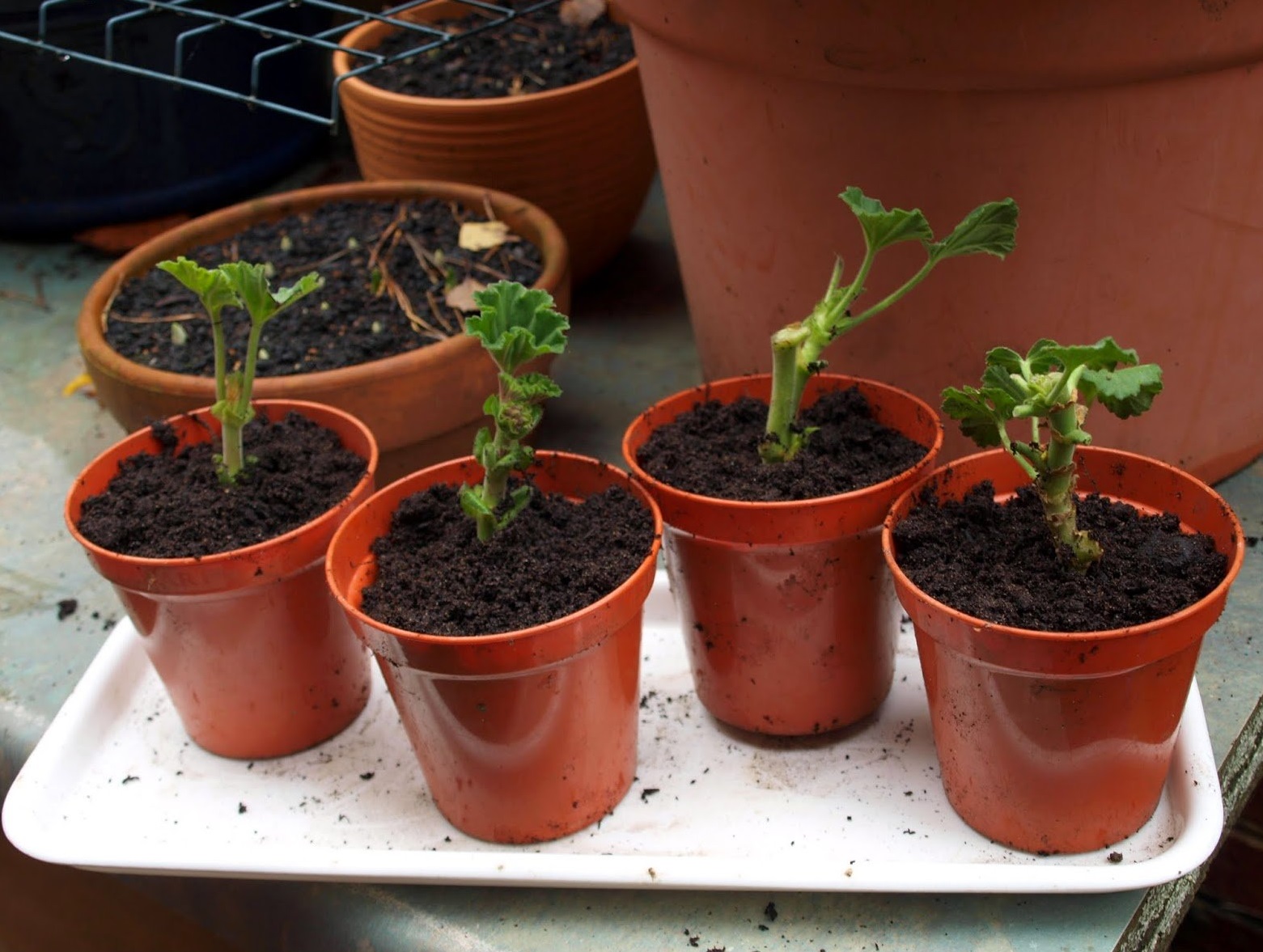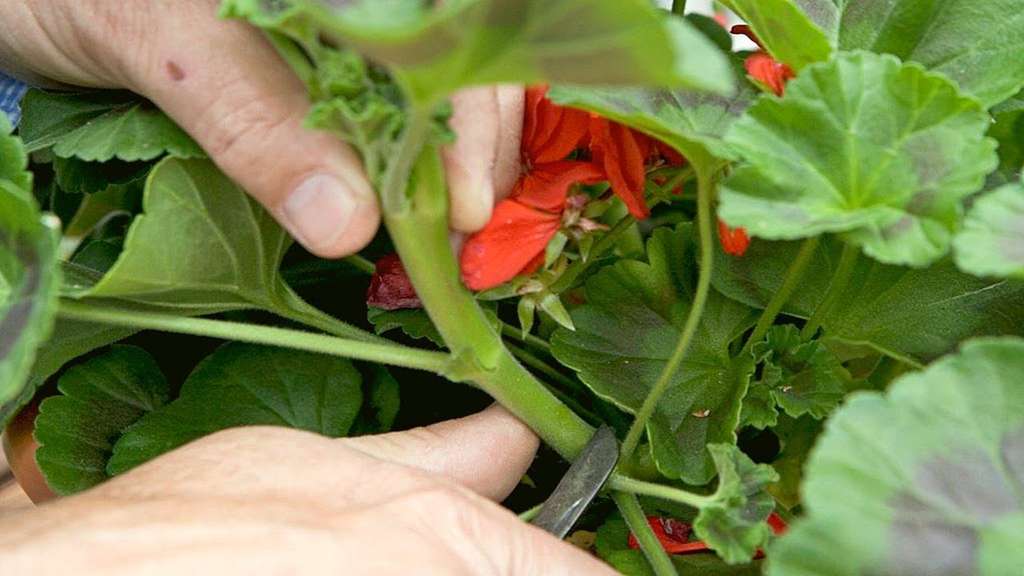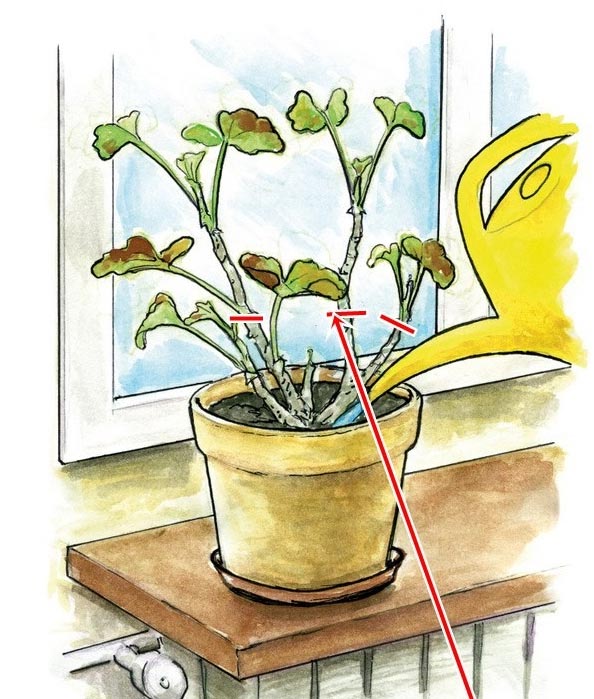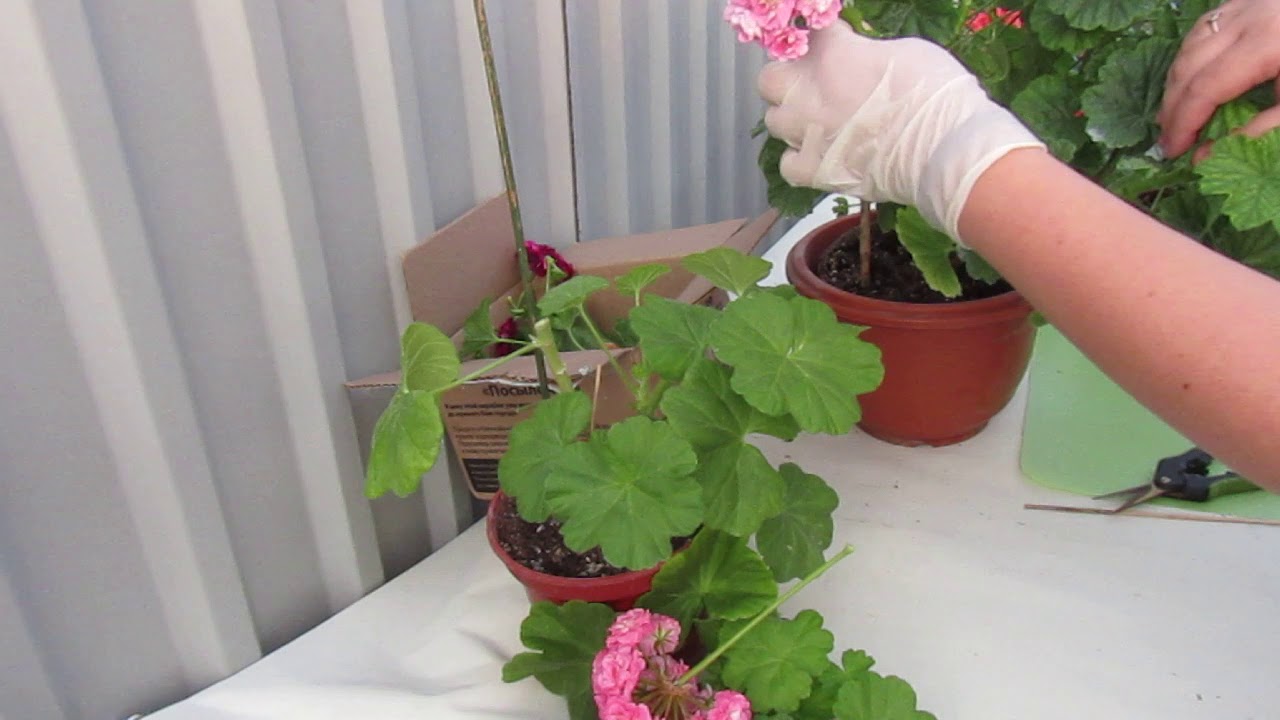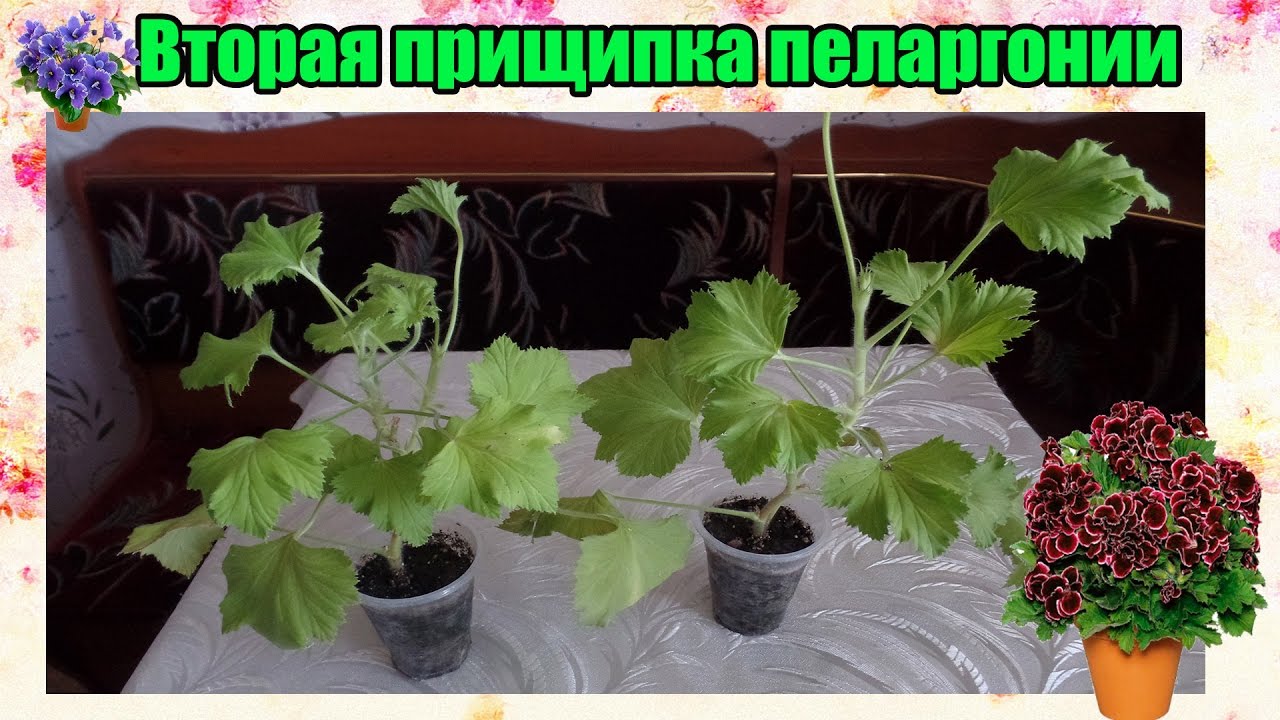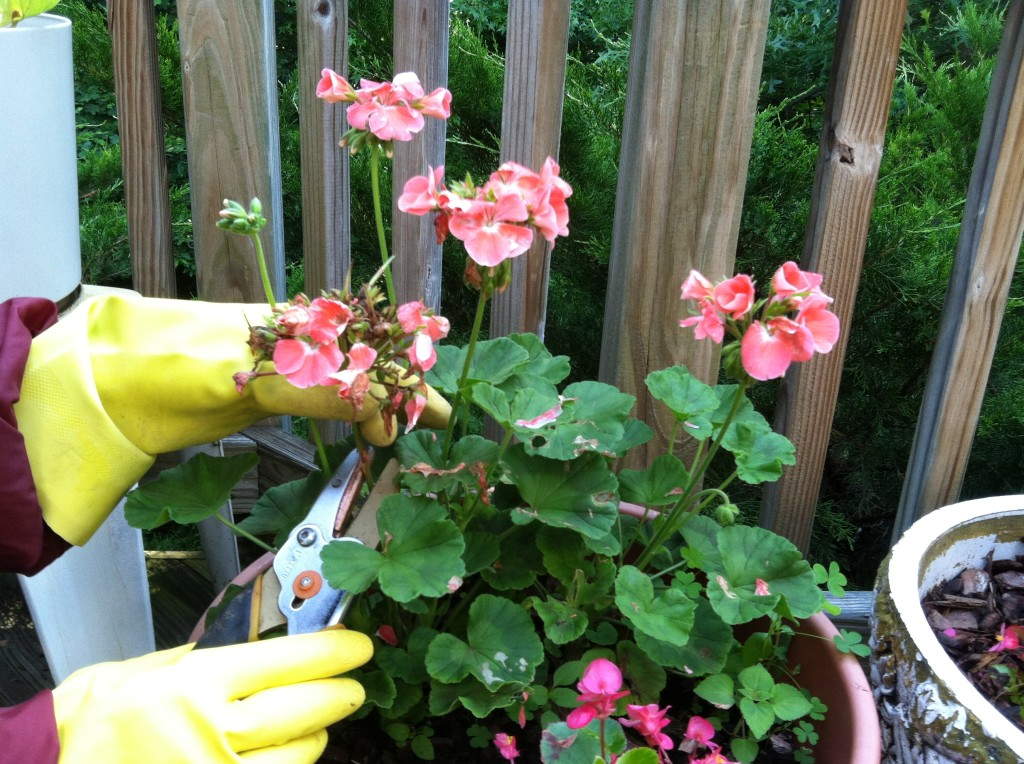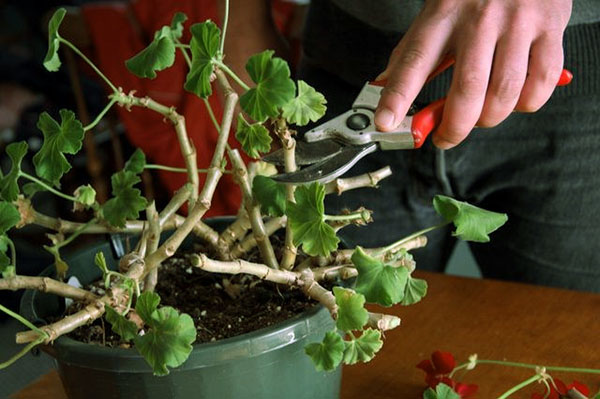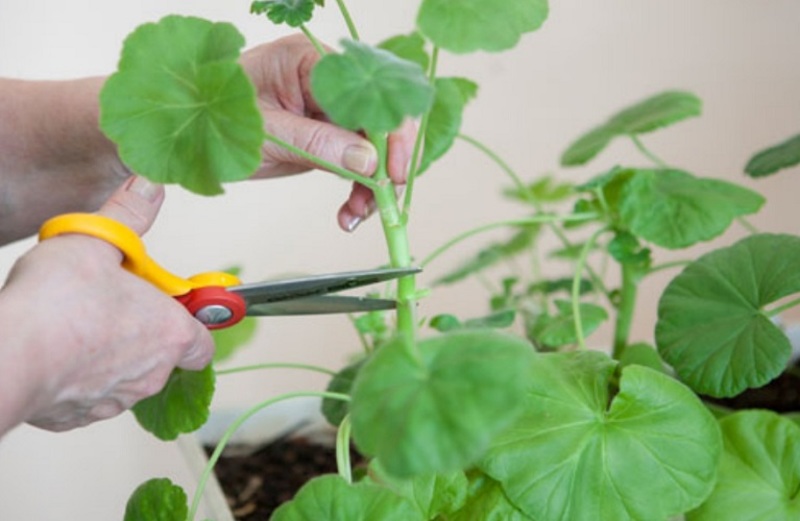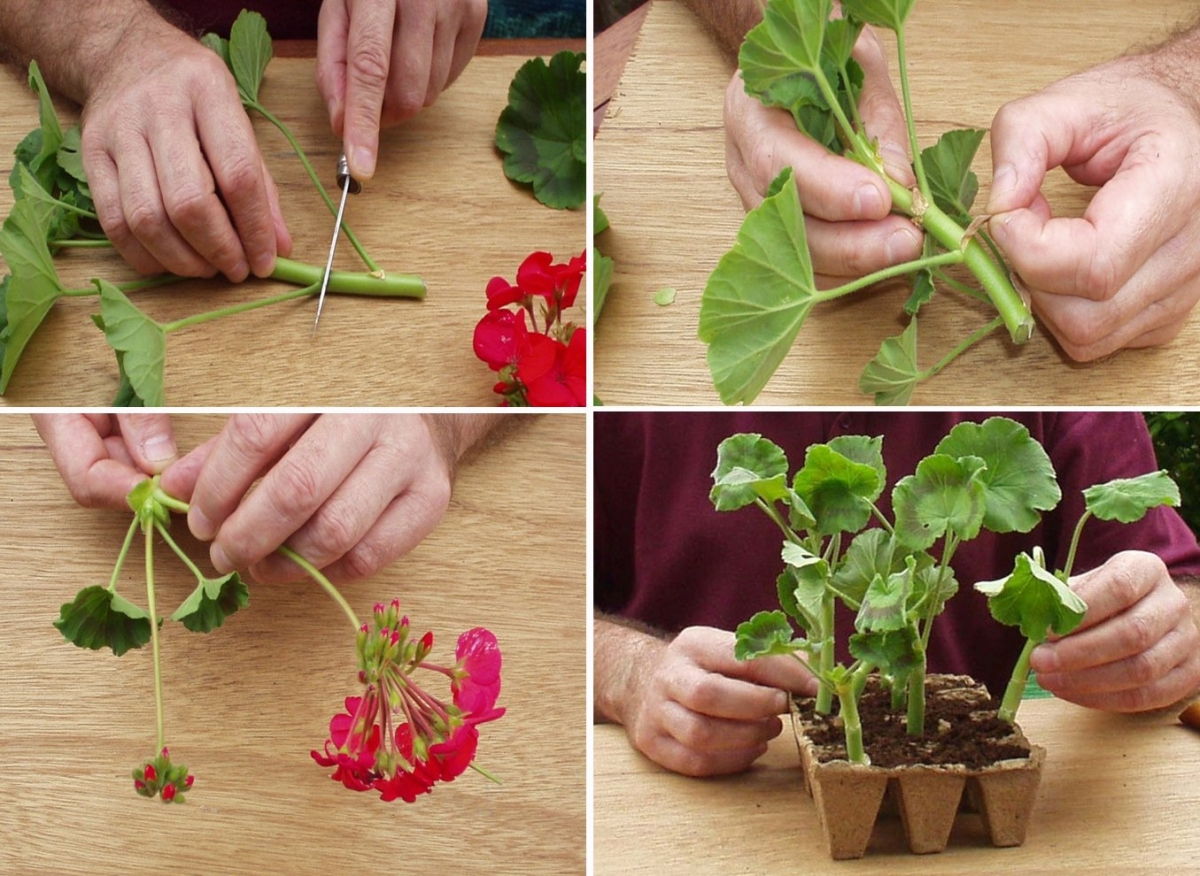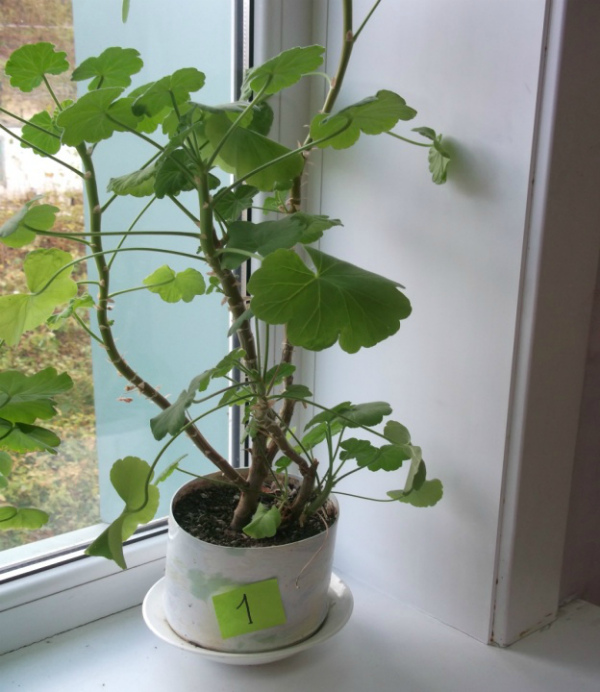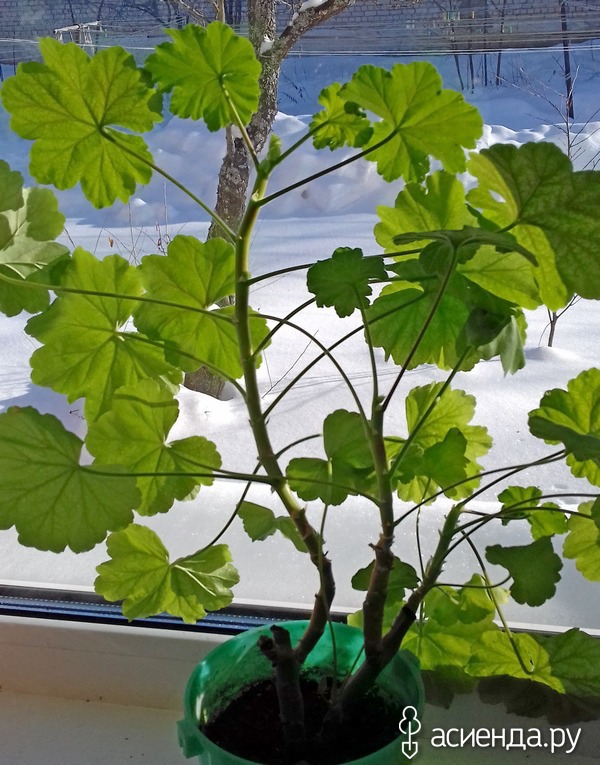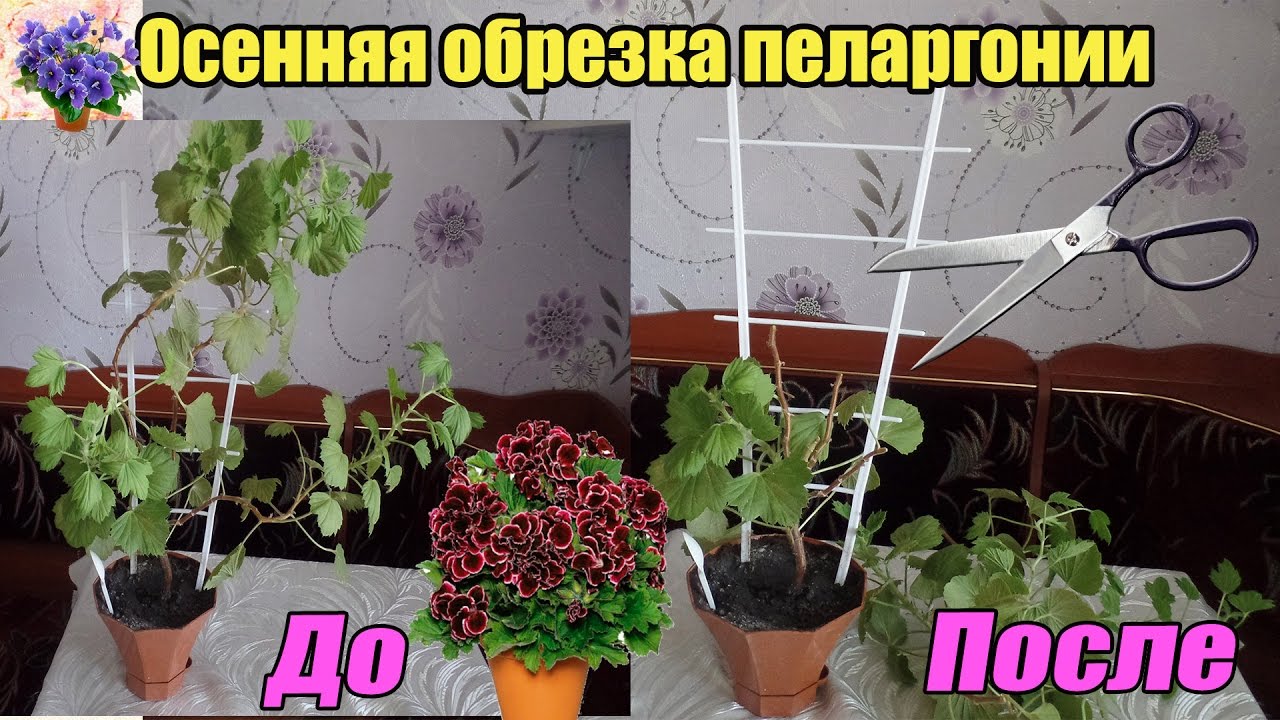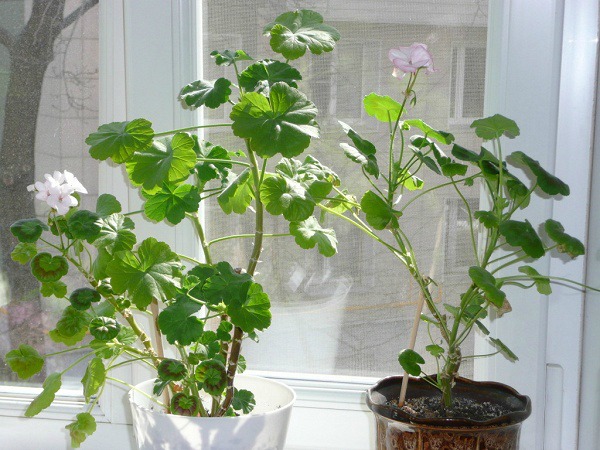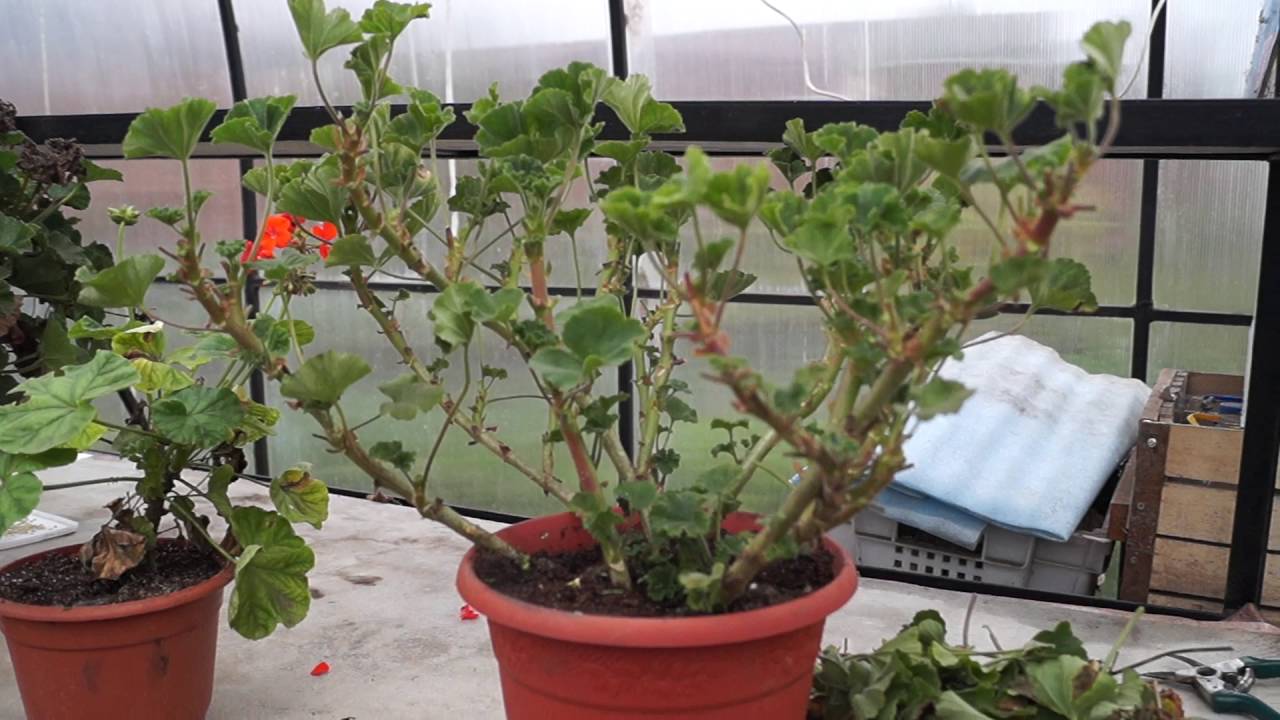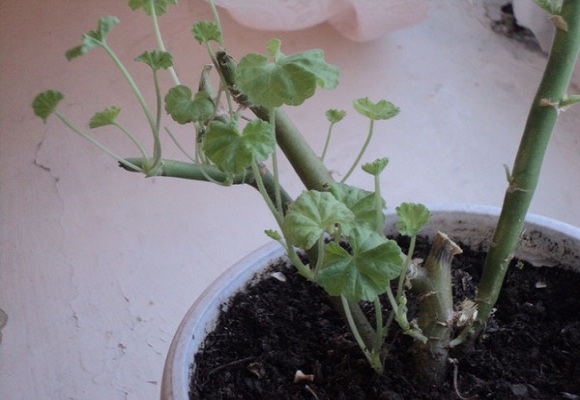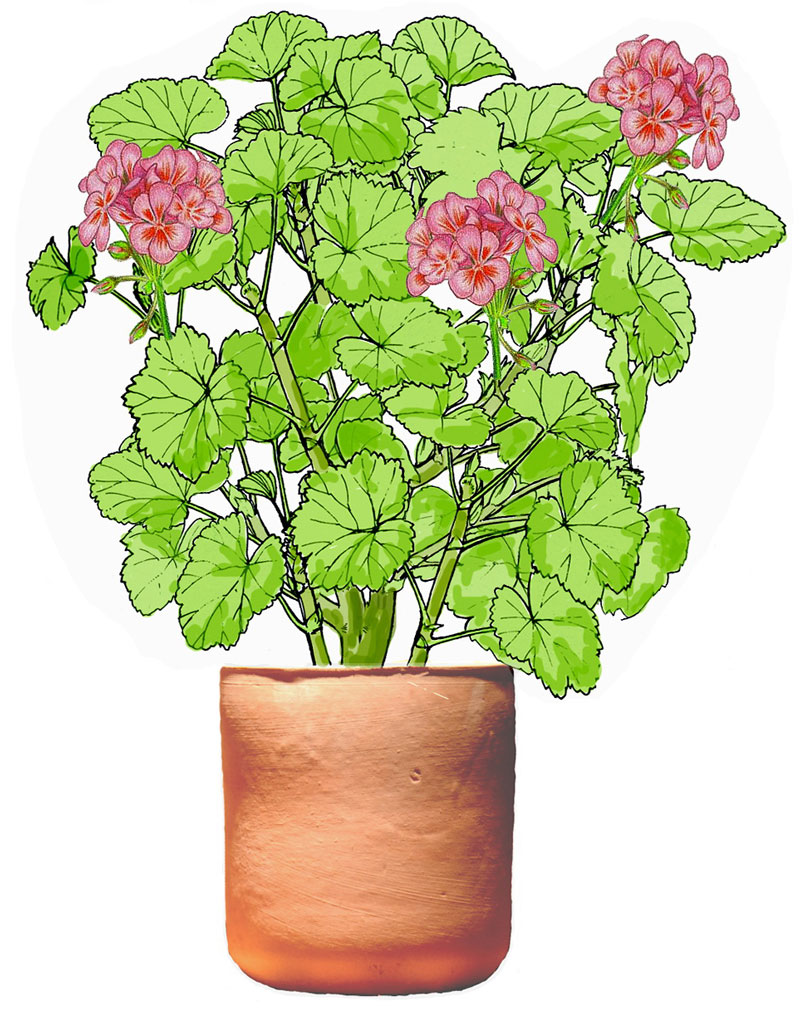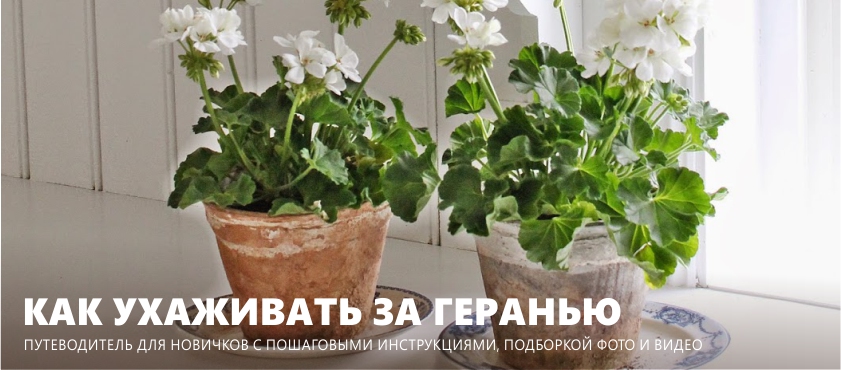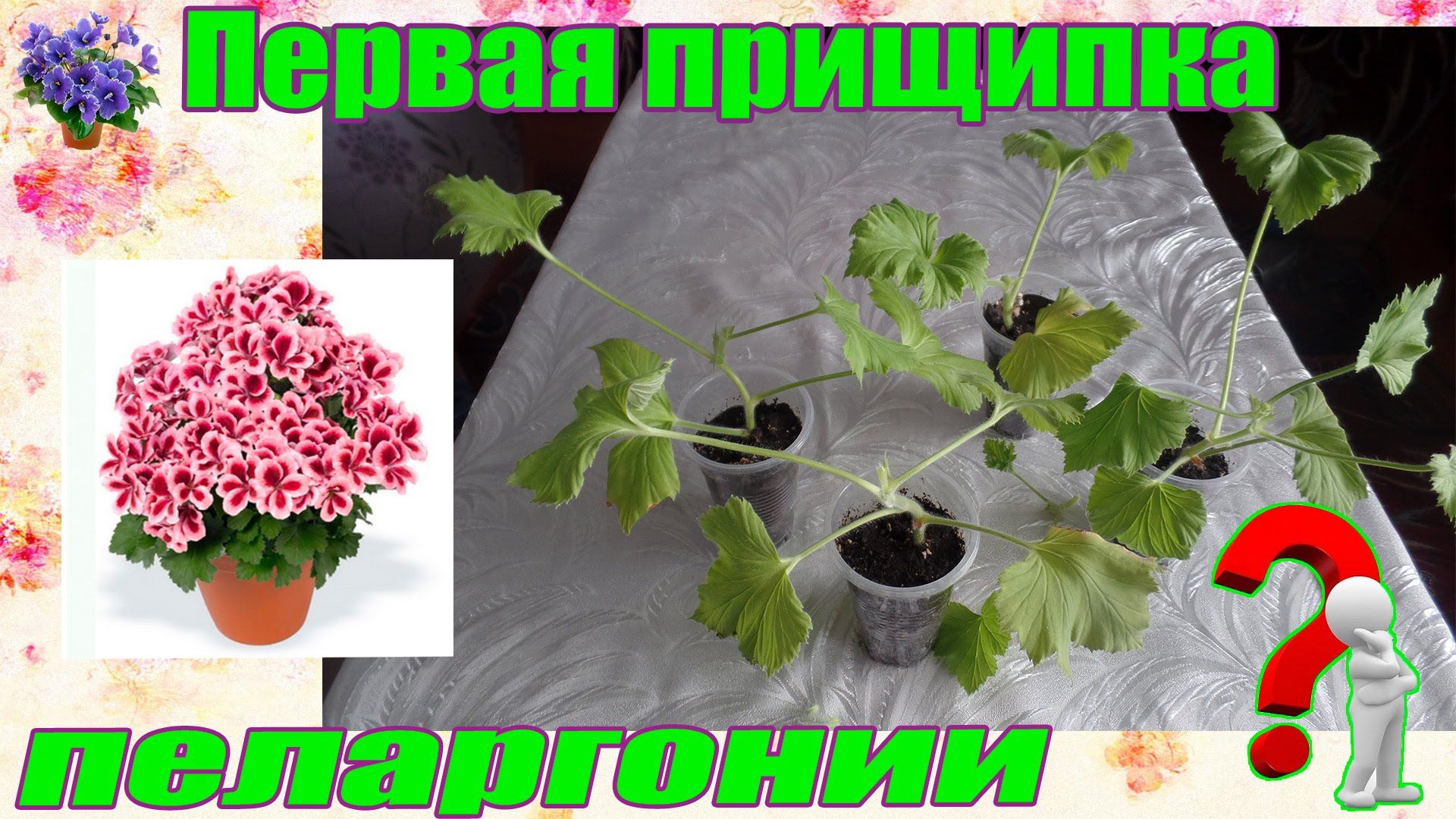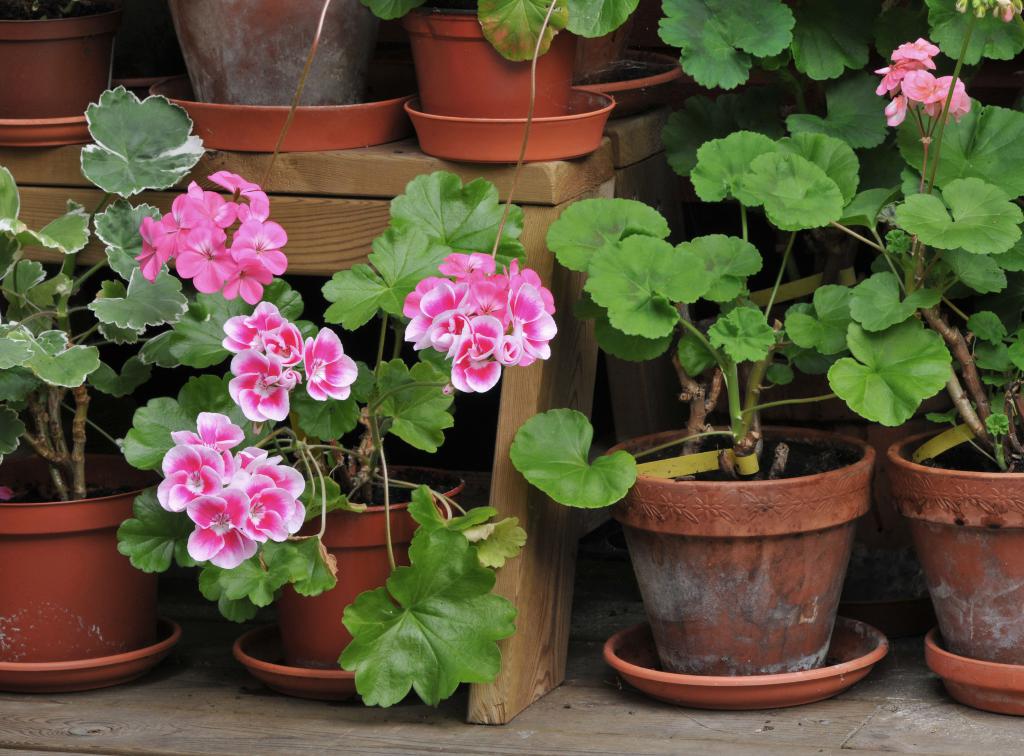Watering
Water for irrigation should be filtered or settled, always at room temperature or slightly warm. Cold water can cause root rot.
How often to water geraniums?
- In summer and spring, it is necessary to water geraniums as the topsoil dries out, about 1 time in 2-3 days.
- In winter and autumn, watering should be reduced to 1 time in 10-14 days.

Remember that Pelargonium, as a South African, is a dry plant, has the ability to store moisture, and tolerates underfilling better than overflow. For this reason, it is undesirable to spray and wash geranium leaves, otherwise they may turn yellow. At the same time, yellowing of the leaves can cause a lack of moisture.
It is important to ensure that no water stagnates in the pot pan after watering. Also make sure there are large drainage holes in the bottom of the geranium pot
Possible problems
There can be many factors in the yellowing of leaves. We will describe them later in this chapter. The leaves can catch fire at the edges, and then completely. This happens with flowers on the street. Too cold air at night will damage the chlorophyll and redden the leaf plates. This is how the plant is prepared for wintering.
Why geraniums don't bloom
Flowering can be affected by too frequent watering. During excessive waterlogging, the buds crumble or do not form at all. When kept very hot, especially in winter, flower buds will not form. One more reason for the lack of colors is the lack of lighting. Pruning too much in the spring can also stop flowering.
In order to get a luxurious and long-lasting flowering, it is recommended to cut the bush in time. In winter, keep it in a cool building with good lighting, lengthen the daylight hours in spring with artificial lighting, in case there is not enough natural lighting.
Excessive use of nitrogen-containing fertilizers can also be a factor in stopping geranium flowering. This manifests itself in lush greenery as well as lack of flowers.
Why do the leaves dry
The factor may be in natural formation in zonal species, when the plant becomes old and strongly stretched. If the leaf begins to dry out from the edges, this is a sign of a lack of fertilizer in the soil. Whitish or yellow spots indicate the appearance of aphids. In case the whole plant is weakened and the leaves turn yellow, this indicates a whitefly. Root rot can also be a factor in the yellowing of the entire flower. To solve these problems, it is necessary to check the plant and exclude all options undesirable for development.
Types and varieties of geraniums with photos
The genus Pelargonium includes 2.5 hundred different species. Some types and varieties of geraniums are intended only for growing at home, and some can also be grown outdoors, in flowerpots or flower beds.
Ivy geranium (Pelargonium peltatum)
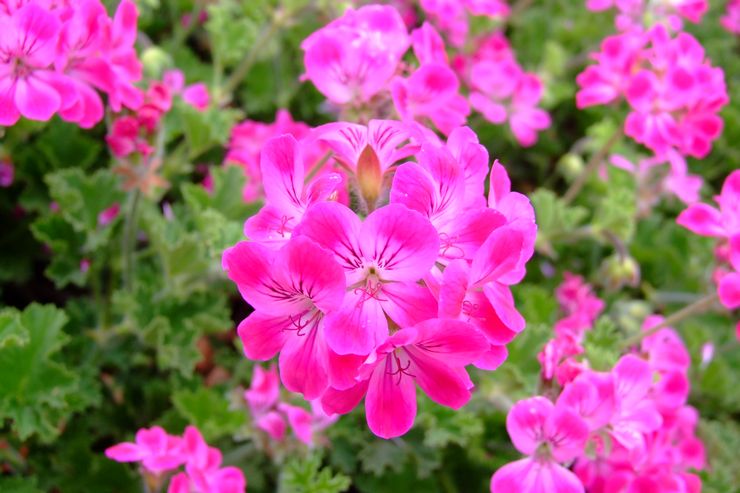
The homeland of this species is southeastern African countries. Due to drooping stems, such geranium can be used as an ampelous one. Foliage sometimes has slight pubescence, but more often it is smooth to the touch. The width of the leaf plates reaches 10 cm.
Flowering lasts from spring to autumn days. One umbrella contains about 8 flowers of white, red or pink color.
Royal geranium (Pelargonium grandiflorum)
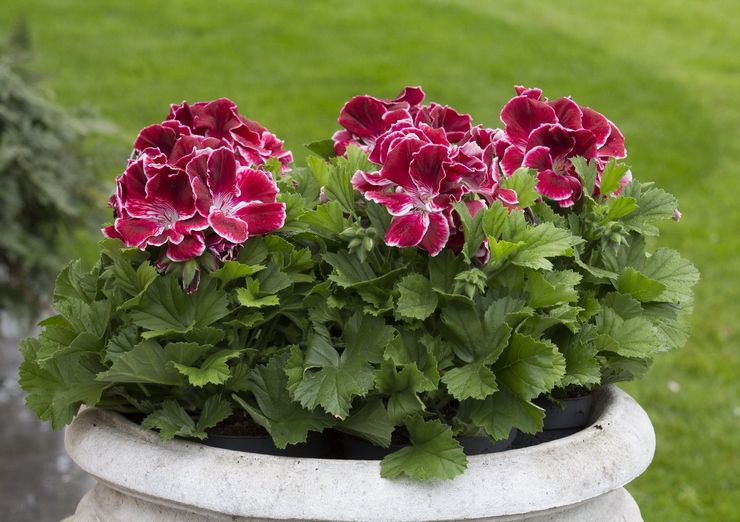
This species is intended exclusively for indoor cultivation. Forms bushes up to half a meter in height. It has a large amount of foliage with a smooth or slightly pubescent surface. At the same time, the leaves have almost no characteristic odor.
The species is distinguished by larger flowers, their diameter can reach 7 cm.Coloring can include all shades of white, red, burgundy, crimson and purple. Flowering lasts from spring to autumn.
Geranium zonale (Pelargonium zonale)
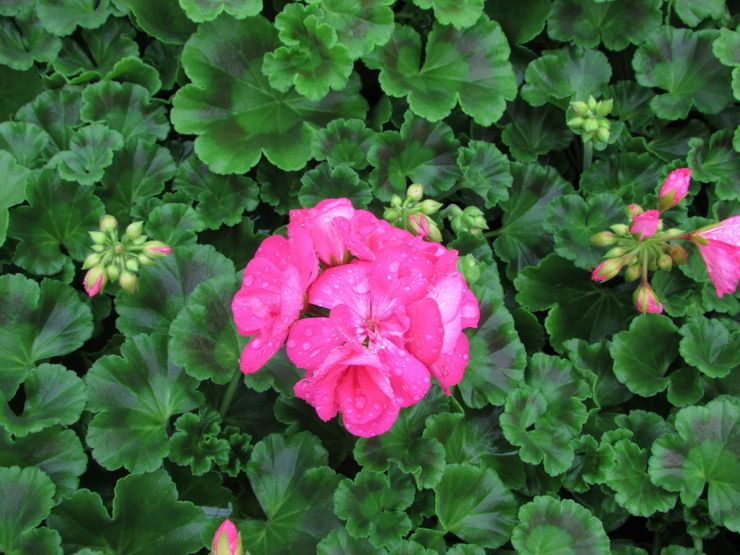
A tall species of pelargonium, whose shoots can grow up to 1.5 meters. The foliage is rounded, with a distinct brown stripe at the top of the leaf. It is smooth to the touch, but may have a little fluff. The flowers are usually red in color. Flowering lasts from March to September-October. Can be grown in the garden, but usually does not hibernate in the ground and requires digging.
Fragrant geranium (Pelargonium graveolens)
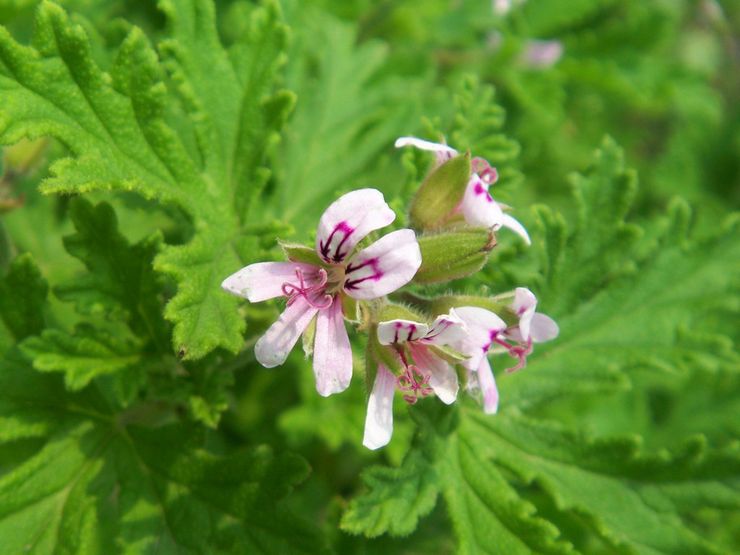
A low shrub, reaching only 22 cm in height. Small (no more than 2.5 cm) foliage has soft pubescence and a pleasant sweetish aroma. This species blooms in summer. About a dozen white or pink flowers are included in one umbrella.
Houseplants Flowering Houseplants
Geranium, home care
Geranium is unpretentious and does not require much attention; in the conditions of an apartment, caring for it is completely uncomplicated. At the same time, it blooms almost all year round. So how to care for geraniums? Read below.
Lighting
Geranium is very fond of light. The stronger the sun, the better. She is not afraid of direct sunlight, however, on especially hot days, it is recommended to shade it a little, otherwise the leaf plates will get burned. On other days, the shadow is a huge risk.
Pelargonium will begin to stretch, and also expose the shoots, the saturation of flowering will decrease, the splendor of the bush will decrease. For this reason, to place it, you need to choose the lightest windows.
If you have purchased an ampelous geranium, it requires special care at home during the first two weeks. Place the flower in a well-lit area without allowing direct sunlight. He needs to be given time to adapt to the new conditions. After fourteen days, you can gradually accustom pelargonium to brighter lighting.
If there is not enough light for her, she stops laying buds for the upcoming flowering. Pre-prepared fluorescent lamps will help to eliminate the difficulty.
Temperature
The optimum room temperature is the conditions when geraniums feel comfortable and develop normally. The minimum favorable temperatures can be temperatures from + 10 ° C to + 15 ° C.
Typically, these temperatures are observed during cold periods, when geraniums are resting from the flowering period. At this time, her place is on the windowsill or in one of the cool rooms.
Air humidity
According to experienced flower growers, geraniums can grow well in any humidity. Therefore, no matter what kind of air is in the room, this will not affect the development of pelargonium in any way.
For the normal development of geraniums, fresh air is needed, which makes it very hardy. Therefore, in the summer it is recommended to keep more of it in the fresh air, or at least grow it on the balcony.
Watering and fertilizing
In winter, geranium (pelargonium) can be watered no more than twice a week and illuminated as much as possible. In the summer, you need to water the plant every day, but in any case, you must avoid excessive moisture and water getting on the leaves. This can lead to root rot and death of the flower.
To prevent this from happening, you need good drainage in the pot. It is better to take water for irrigation at room temperature and not too hard. The geranium pot should be small so that the roots fill it completely, then the plant blooms better and is less sick.
In case your beauty ivy (ivy) geranium is planted in open ground, it needs to be fed only once a month with fertilizers for flowering plants.
In order for the plant to amuse with abundant flowering, during the development of buds, use products with an increased content of potassium and phosphorus. They are required to be applied immediately after watering to wet soil.
Geranium transplant
Under normal conditions at home, geraniums do not essentially need transplants.
An exception may be some cases, if, for example, the roots of the plant have increased, and there is not enough space in the pot, or the plant has been flooded with water through negligence.
Whether it is planting or transplanting, remember that the flower does not accept free pots, but good drainage will come in handy. The plant can easily be transplanted with ordinary garden soil or universal soil mixture. Particularly comfortable conditions for a plant are the following recipe:
- 8 shares of turf
- 2 lobes of humus
- 1 share of sand
Errors when pruning geraniums at home
Pruning geraniums is not such a difficult process. The only thing that must be observed is the timeliness of its implementation. But improper pruning will lead to an unplanned result or the death of the plant.
| Trimming errors | Possible consequences |
| Violation of the timing of pruning | Winter pruning is undesirable. Pruning the shoots during flowering will cause the buds to fall off. |
| Cropping high above the leaf node | The upper part of the stem dries up, up to its complete withering away, the aesthetic appearance of the plant is lost. |
| Pruning a large number of shoots | The plant is difficult to survive stress, does not come to its senses for a long time, does not bloom. |
| Very frequent pruning | The formation of flower buds is inhibited. |
Geranium pleases the human eye with beautiful flowers and a peculiar aroma. To create a well-groomed pelargonium bush is within the power of every grower. To do this, it is enough to prune the plant in time and provide it with proper care. Lush blooming geraniums need potassium supplementation. This is where all the secrets of creating a spherical crown or a fluffy geranium bush end. Enjoy your sight.
Planting and transplanting
Geranium is one of the few plants that rarely needs replanting. It can grow in one pot for many years. The exceptions are cases when the pot has simply become cramped for overgrown roots.
Do not take a pot for transplanting too large. The new container should be 1.5 - 2 cm larger than the previous one. The material from which the pot is made does not matter, but it should be remembered that in clay containers the soil dries out faster. There must be holes at the bottom of the pot to drain excess liquid.
Geranium is also unpretentious in terms of soil. For her, a universal soil or ordinary garden soil is suitable. But if you decide to prepare the soil mixture yourself, then you will need the following ingredients:
- 4 parts of sod land;
- 1 part of humus;
- half of the sand.

Unpretentious geranium does not require a special soil mixture
Step-by-step transplant process
Transplanting geraniums is very easy. Even an inexperienced florist can easily master this process.
-
Pour a drainage layer into a new container, a little prepared soil on top.
-
It is best to transplant geraniums using the transshipment method. We carefully remove the flower from the old pot and place it in the center of the new container.
- Pour fresh soil mixture into the formed voids on the sides. Slightly compact with your fingers and water.
- Be sure to drain the water drained into the sump.
What else you need to know when boarding or transferring
- After purchase, geraniums need a week or 10 days to adapt to new conditions. After that, you can carry out a transplant.
- When transplanting a purchased plant, carefully examine its roots. If they are healthy, then you should not completely remove the soil. Shake off only those particles that come off easily by themselves. It is necessary to completely get rid of the soil only in the case of root rot.
- The time to transplant geraniums is March - April.
- It is better to leave a flowering plant alone until the end of the process.
Do you need support
If the bush geranium does not form, and you allow it to grow as you please, then support for the plant will be needed.The fragile stems of an adult flower can break without additional support. The options for structures can be different - an ordinary bamboo stick, a ladder or a circular support. Ampel species do not need support.

If the geranium is not pruned, it will need support.
Varieties of room geranium
There are several types of indoor geranium:
- Climbing geranium or ampelous has elongated branches up to 900 mm long, going down. It is more convenient to grow a flower in a suspended planter. Tassel-shaped inflorescences are purple, red or white, and are placed on the tops of the flowing stems. The surface of the leaves is smooth. This species has about 70 varieties, it is also called ivy geranium or curly geranium.
- The royal variety is the most capricious. It is a shrub 30-60 cm high with large double flowers and umbrella-shaped inflorescences. Usually flowers are white or purple in color. There are also varieties with spotted flowers. Rounded leaves have a serrated border.
- Fragrant geranium or zonal pelargonium is the most common species. The height of the bush reaches 80 cm. Rounded leaves with yellow, white or brownish edging are located on long stems, the tops of which are decorated with inflorescences in the form of umbrellas. The color of the flowers is from white to purple or burgundy red.
- Scented geranium has a pleasant aroma. There are varieties with the scent of rose, lemon, cinnamon and apple. There are only about 150 species. Small decorative leaves. On one stem, one small butterfly-shaped flower grows. This variety does not always bloom in a warm room.
- Geranium pink or rosaceous has reddish or pinkish flowers that resemble small roses. The texture of the petals is smooth and the inflorescence looks like a miniature bouquet of roses. The leaf plates have a coating in the form of a fine mesh.
Popular species and varieties
All types of pelargonium are very decorative. They differ in color, leaf shape. In addition to natural forms, interesting hybrid varieties have been bred.
- Pelargonium is tulip-shaped. An interesting variety. Flowers resemble closed tulip buds, collected in bouquets.
- Pelargonium royal. Low shrub. The leaves are rounded, slightly dissected. The surface of the leaves is slightly pubescent or smooth. On each pedicel, 2-3 flowers are collected. The most common color is white with scarlet veins.
- Pelargonium is zonal. Tall shrubs up to one and a half meters in height. The branches are slightly pubescent. The leaves are round or lobed, pubescent or smooth. The umbrella inflorescence consists of a large number of flowers. The colors are predominantly scarlet. Long bloom - from spring to autumn.
- Fragrant pelargonium. A small bush up to 22 cm with short shoots. The leaves are rounded, the shape is close to cordate. There are small notches along the edges, the surface is pubescent. The inflorescence is umbellate. The average number of flowers per inflorescence is about 10. The smell is pleasant. The flowers are light, most often pink. Blooms in summer.
- Pelargonium ampelous (ivy). The branches are long, drooping, grow up to a meter. Grown in apartments in hanging pots, used as a ground cover in landscape design. The colors are varied - ranging from white and red to almost black. The leaves are shaped like ivy, rough, smooth.
It is interesting! The people of Pelargonium are attributed to mystical properties. It is believed that red pelargonium brings good luck in love, white - helps in the birth of children. According to the art of feng shui, the energy of the flower is favorable.
Diseases
Unfavorable environmental conditions and violation of the rules of care provoke the development of diseases. It is possible to determine the type of disease by characteristic visual signs.
Blackleg
Fungal disease often affects immature seedlings. The disease is manifested by blackening of the root collar, the appearance of decaying areas and lodging of seedlings.
Gray mold
In case of damage by gray mold, dry spots form on the stems. In the absence of a fight, the disease spreads to foliage and flowers.
Leaf rust
A characteristic symptom of leaf rust is the formation of orange or brownish growths. Over time, the growths crack, and the spores of the fungus spill out of them.
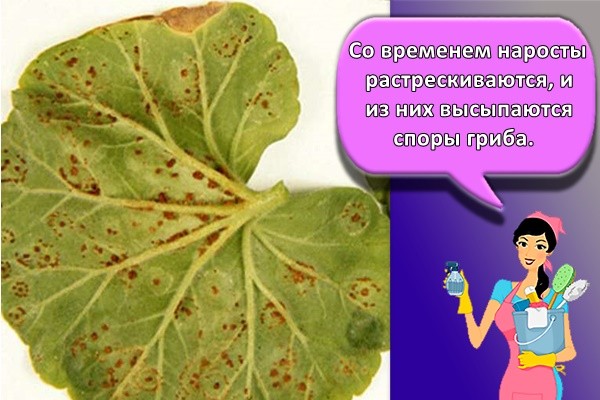
Powdery mildew
The primary sign of a powdery mildew infection is the formation of a white mycelium. Plaque occurs on petioles, young shoots and the surface of leaf plates.
Oedema, edema
Oedema appears as small pimpled growths. When the disease spreads, the entire side of the leaf plate is covered with growths.
Verticillary wilting
The fungus that causes verticillary wilting is in the ground and can lead to the death of the plant. The leaves of the affected flowers begin to curl and tilt towards the ground.
Gray rot
Gray rot is manifested by the appearance of spots on shoots and leaves. The spots quickly enlarge and cover with a bloom, which consists of spores and mycelium.
Stem and root rot
The reasons for the development of rot are excessive watering and feeding. The consequence of the disease is the colonization of the roots with soil destructive fungi.
Stem and root late blight
Signs of late blight are brown spots surrounded by mold or covered with bloom. The affected areas die off, which provokes the death of the plant.
Other problems
In addition to disease, there may be other difficulties in growing pelargonium. It is worth familiarizing yourself with possible problems in order to try to avoid them.
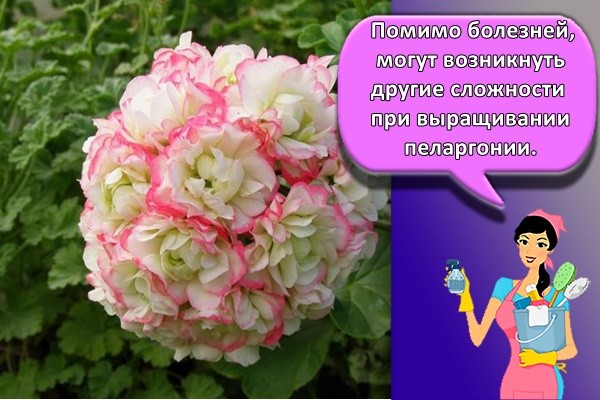
Leaves turn yellow and dry
The yellowing and drying of the leaves is associated with a lack of fertilizing. It is recommended to use complex fertilizers to saturate plants with nutrients in the right amount.
Wet and loose leaves
The structure of the leaves deteriorates due to waterlogging or attack by pests. Outwardly, the foliage looks shriveled and withered.
Pink tan on the leaves
This problem can occur due to burnout of leaves.
It is important to ensure that the green part of the flowers is not burnt by the sun's rays.
Falling foliage
Pelargonium leaves crumble due to drafts or temperature changes. In winter, partial subsidence is a natural process.
The pot is too large
In an unsuitable container, the plant will not develop properly. For small pelargonium, you need to choose the appropriate pot.
Excess nitrogen fertilizers
Excessive application of nitrogen leads to disruption of the vegetation process. Fertilizers should be applied in portions and in small quantities.
The purpose and benefits of spring haircuts
Spring pruning is easier than autumn pruning and is more beneficial to the plant, but should be done with caution. During this period, sap flows are started in pelargonium, rest ends
In order to determine whether it is necessary to subject the flower to pruning, its appearance is assessed.
Need
To understand whether pruning is necessary for geraniums, you should pay attention to its appearance. The bare trunk is not cut, but if the shape is neat, you can subject the plant to spring pruning. At the same time, I remove all stems growing inward, old branches, side shoots that break the shape
In ampelous species, remove all long branches devoid of foliage and inflorescences.
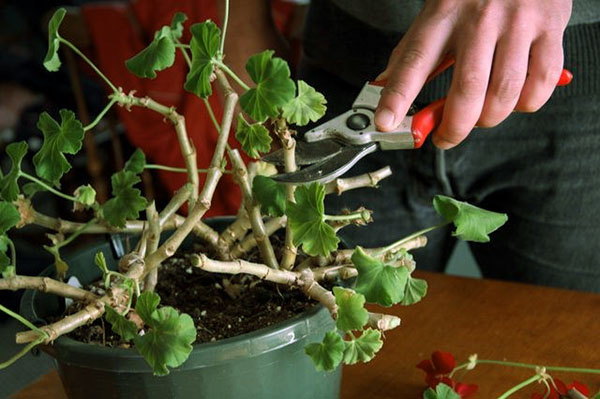
What does cropping give? She favors:
- long flowering;
- growth of lateral branches;
- the formation of an even beautiful crown;
- obtaining fresh planting material for planting new plants.
Scheme of the procedure
First of all, you need to decide what shape to give the flower. After that, you can start the procedure according to the generally accepted scheme:
- the instrument for manipulation should be disinfected. For these purposes, boiling water, alcohol or an antibacterial agent is suitable;
-
remove all yellowed leaves and damaged branches;
Pruning with scissors
- shorten the high stem, in which case new shoots will begin to grow from it, and the plant will take the shape of a tree;
- remove the lower side shoots;
- trim off any old crooked stems, leaving the stumps. In the future, bushes are formed from these stumps.
Pay attention! There is an unspoken rule for pruning geraniums - it is necessary to remove no more than a fifth of the shoots, otherwise the timing of the flowering of pelargonium will significantly shift. After the procedure, the cut sites are treated with ash or cinnamon, you can use crushed activated carbon, alcohol solution or brilliant green
Care after pruning
In order for the geranium bush to recover quickly after the pruning, it needs to create several gentle conditions:
- provide normal and acceptable air humidity, periodically spraying;
- slowly and carefully adjust and normalize the watering regime;
- provide geraniums with maximum light by placing it on the most lighted windowsill (preferably southern);
- create the necessary, slightly warmer conditions by raising the temperature (compared to winter content) by 3 ... 5 ° C;
- feed with any universal nitrogen-containing fertilizer for flowering indoor crops (Hera, Agricola, etc.).
Table: caring for geraniums after spring pruning
| Temperature | A temperature rise of 3-5 ° C is allowed (compared to winter temperature). |
| Lighting | Intense, preferably south-facing window. |
| Watering | A gradual return from moderate winter watering to normal watering. |
| Top dressing | Spraying with Epin's solution (once a week, three times a month). |
| Air humidity | No promotion required. |
Reproduction
It is possible to propagate the culture, both by cuttings and by seeds. In the first version, you will receive a copy of an existing plant, and when using the seed method, a completely new species. In addition, reproduction is used by the method of dividing the rhizome, however, in this case, special skills will be needed, so it is better not to use this method without specialized experience.
Cuttings
Spring is the best time to propagate pelargonium by cuttings, but in fact, it is possible to cook cuttings all year round, for example, during pruning. Cuttings can be up to seven centimeters long and two to three leaves
It is important to lightly anchor the planting material during the first day, and then sprinkle all the cuts with crushed coal for disinfection
In some situations, it is possible to root cuttings in coarse sand, but it is important to take care that the soil is moist all the time. Shelter is not required for sprouts, however, during watering, care must be taken so that water does not end up on the leaves and shoot
In the room where the cuttings are located, a fixed temperature level is maintained (approximately + 20 + 22 degrees). At the time when roots appear on the seedlings, they are transplanted into perpetual pots.
Seeds
Despite the fact that the reproduction of pelargonium by seeds at home is rarely practiced, this method is also considered quite simple and effective.
It is advisable to sow seeds in moist, loose soil. The planting type of material is evenly divided over the surface and sprinkled on top with a layer of soil, two and a half centimeters thick. Next, sprinkle the ground with water and cover with glass, so that the best humidity is maintained inside. Seeds germinate when using a temperature of + 18 + 22 degrees.
After the emergence of the first shoots, the shelter is removed, and the container with the seedlings is moved to a well-lit space and kept at a lower temperature (approximately + 16 + 20 degrees). Already after one and a half to two months, the first leaves will appear on the sprouts, and they can be planted in separate containers. During the growth of seedlings, pinching is performed in order to enhance tillering.
How to help the plant?
When an ovary appears, it is important to eliminate obstacles to the formation of inflorescences:
- Flowers in direct sunlight will not be bright.
- In winter, coolness is beneficial for the plant, but temperatures below 10 degrees will not do good and will stimulate the plant's premature awakening from hibernation.
- The southern windowsill, where there is a lot of sun, is the best place for geraniums.
- For lush flowering all year round, the prerequisites are food and lighting.
- Lots of branches - lots of flowering space. To enhance branching, the shoots are pinched.
- Withering flowers are removed immediately.
- With regular pruning, geraniums rejuvenate and gain strength to grow.
- Geranium grown from seed blooms four to five months after sowing. During this time, the plant is gaining vegetative mass.
Prerequisites for lush flowers
For a beautiful, lush flowering, a florist needs to comply with several conditions:
- Lighting. Plants prefer diffused light, otherwise the leaves turn red or yellow, if there is not enough sunlight, there will be no flowering.
- Temperature. In winter, 13 degrees are enough for the plant, otherwise, the stems are exposed, the foliage crumbles. In summer, they maintain a temperature of 18-20 degrees and shade the pots. You can plant it on the balcony or take the pot out to the front garden for fresh air.
- Humidity. Maintain soil moisture, foliage spraying is prohibited.
- Fertilizer. In the spring, fertilized twice a month, in the summer - once enough. For indoor cultivation, organic fertilizers are not used, phosphorus, nitrogen and potassium are added in equal proportions. Do not fertilize in winter and in extreme heat.
Geranium transplant

If geranium grows at home, then replanting it is not necessary. However, when the roots grow very much, then they become cramped in a small pot. This happens with an already mature plant. An urgent transplant is also required if the plant has been flooded with water, but it can still be saved. The geranium pot should not be too spacious. The size of the root system and the volume of the pot should be approximately the same. Be sure to put good quality drainage in the pot. Many gardeners say that geraniums are suitable for a simple country land. The plant can also grow on a mixture of leaf, turf, humus soil and sand (1: 1: 1: 1/2). The transplant must be carried out in the spring.
Home geranium care for beginners
The houseplant geranium may well serve as a gift for a young housewife. She is absolutely unpretentious and very resistant to mistakes in care. Signs of problems can be seen in the absence of flowers, yellow foliage, darkening of the trunk. If you adhere to simple rules for caring for this beauty, there will be no problems with her.
Illumination and temperature conditions
Illumination directly proportionally affects the intensity and duration of pelargonium flowering. Therefore, it is worth choosing a place for it on the western or eastern windows. An unpretentious beauty can grow in shade, but with a loss of decorativeness. Its leaves will be small, rarely planted. The shoots will begin to stretch, and small flowers will bloom at their ends.
Note! Geranium has fully adapted to the climate of Russia. She feels comfortable in summer on open terraces, balconies
It can be planted outdoors in summer. In flower beds, the flower can be kept until the first frost.
In winter, the temperature should not drop below 10 ° C. Optimal for pelargonium in winter is 15 ° С, but not higher than 18 ° С. Such a regime will provide a dormant period for the plant. If there is no way to lower the temperature, the flower needs to be highlighted.
Watering rules and humidity
In the summer, watering is needed regular and moderate. Roots and cuttings are easily exposed to gray rot, which appears with excess moisture. Drainage for geraniums is very important. In the summer, watering is needed 2-3 times a week as the soil dries out. Complete drying out of the soil in the pot is detrimental to the flower.
Important! In winter, watering depends on the geranium wintering regime. If rest is ensured, watering is reduced to a minimum
If the flower does not sleep in winter, it should be watered after 1/2 of the soil in the pot has dried.
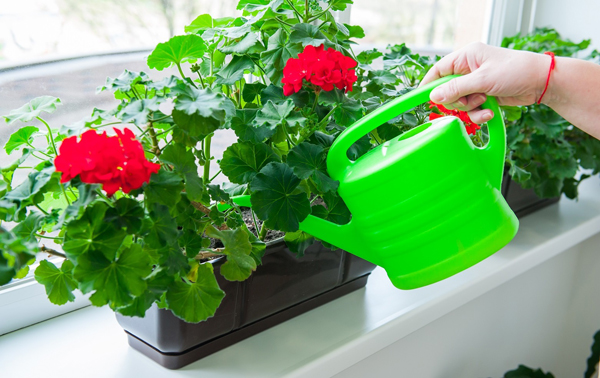
When watering, use a long-nosed watering can to prevent water from getting onto the leaves.
It is necessary to maintain humidity for geraniums in the summer on hot days. Saves wet expanded clay in pallets under the pot. Aqua soil, placed in containers near flower pots, is perfect. Spraying is not suitable for geraniums.
Top dressing and soil quality
To maintain active flowering, you need to help the flower by applying mineral fertilizers. Once every two weeks, and sometimes every 10 days, the flower is fertilized with complex agents containing potassium, phosphorus and nitrogen. Organics are not suitable for this plant. In winter, fertilizing will spoil its decorative effect.
The soil for pelargonium needs a light one that does not retain moisture. If you prepare the substrate yourself, you need to mix garden soil, sand and peat.
An important factor for comfortable growth is the supply of air to the roots. This should be done through good drainage holes and by loosening the soil after watering.
Flower container size
The pot should appear cramped at first glance. It is in such a flower that it will actively and vigorously bloom. If the pot is large, the geranium will build up the root system and greenery, it will not be up to flowering. Also, excess liquid accumulates in a large pot, which provokes rotting of the roots.
Pruning and replanting
Pruning for geraniums is needed in the fall. It is best to cut off the shoots, leaving 3-4 buds. During the winter, geraniums will grow shoots. In the spring, they should be pinched to get a dense bush.
Some growers prune the bush in the spring, after the shoots have stretched out and become bare. Such pruning can cause delayed flowering, as the plant needs time to recover from the procedure. Also, in winter, unnecessary waste of energy reserves is obtained for the growth of shoots, which will eventually be cut off.
Important! Royal Pelargonium cannot be cut
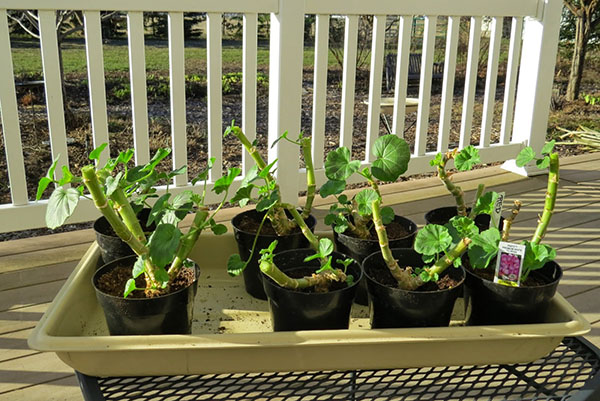
After pruning, geraniums bloom more abundantly and larger
Indoor geranium is painful to transplant. It is transplanted only when the roots no longer fit into the pot. It is better to transplant by a transshipment method and take a pot with a diameter of 1-2 cm larger.
How to care for pelargonium?
Geranium is a perennial thermophilic plant that hibernates indoors. She needs proper home care and regular pruning.
Watering regime In the summer, watering geraniums is required abundantly so that the plant does not dry out from the heat. But it is impossible to overfill geraniums too much. Gray mold will appear on the leaves, the leaves will wither, the roots will begin to rot. In summer, watering must be done daily so that the plant can bloom profusely.
Winter is a hibernation period when watering the plant is required in moderation.
Illumination
Geranium loves light. This is her first condition. A sunny windowsill is the best place for her. But from direct scorching sunlight, the leaves can get burned. In the garden, it should be planted in a well-lit place, but closed so that there are no drafts and wind. From a long stay in the shade, only small leaves will appear. The plant will not bloom.
Air humidity
Humidity does not play a special role for geraniums. She can endure any atmosphere. But it is not recommended to spray the flower. Geranium only loves fresh air. In the summer, she should be in a flower bed or balcony.
Air temperature
The temperature regime for this plant starts from +12 degrees. When the air temperature drops, the stems become bare, the leaves droop, geranium will not bloom. The plant will die. In winter, it tolerates room temperature very well.
Feeding pelargonium
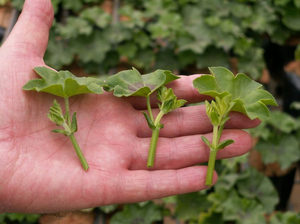 Pelargonium does not tolerate when fresh organic fertilizers are applied. Nitrogen, phosphorus and potash fertilizers are useful. They are taken in equal parts. Potassium is needed for abundant flowering.
Pelargonium does not tolerate when fresh organic fertilizers are applied. Nitrogen, phosphorus and potash fertilizers are useful. They are taken in equal parts. Potassium is needed for abundant flowering.
Fresh organic fertilizers must be excluded immediately: pelargonium does not tolerate them. Fertilizers containing nitrogen, phosphorus, and potassium in equal proportions are suitable. For lush flowering, it is precisely potassium that is required. Be sure to observe the following condition: do not apply fertilizers in hot weather. If the soil is dry, then it must first be watered, and then liquid fertilizer should be applied so as not to burn the roots of pelargonium. In spring and summer, fertilizers are applied at least 2 times a month.
Transfer
Geranium often does not need to be replanted. But if the roots are very overgrown, then the pot will be small. The roots can be trimmed slightly. If the geranium is flooded, then an urgent transplant is required. A large pot should not be taken. The land can be taken from the summer cottage by putting drainage on the bottom of the pot. The plant is transplanted in the spring.
Reproduction
Pelargonium is propagated by seeds and cuttings. Home care requires propagation only by cuttings. The plant reproduces by seeds only when a new variety is developed. Before planting seeds, the soil is loosened and watered with a solution of potassium permanganate. This will protect her from the black leg. It is not required to cover the seeds with a large layer of earth. The container is covered with foil or glass and left in a warm place until shoots appear. Reproduction by cuttings is done in the spring. The stalk is placed in a container of water. The room should be warm. After the roots grow back, the cutting is transferred to a pot with soil. After its rooting, you need to pinch off the top. Professionals can reproduce pelargonium by dividing the bush.
Plant pruning
Plants should be pruned regularly. There should be two pruning: in spring and autumn. The pruning rules are simple.
Forming pelargonium bushes will help:
- give the bush an even and compact shape;
- cause the growth of side shoots;
- make the bush lush and stable;
- get quality home material for planting.
In spring, pruning of geranium bushes is less extensive than in autumn. Work begins in early March. The later the excess shoots are cut off, the later the flowering begins. In spring, only weakened stems should be trimmed. 2-3 buds should remain below.
How not to harm flowers
Pruning geraniums is a simple procedure, especially if you follow the correct sequence and remember the basic needs of the plant, including seasonal ones. Nevertheless, there are times when the bush dies due to rash actions.
The main mistakes of novice florists
The process of removing geranium stems is quite simple, but sometimes novice growers make mistakes, the result of which can be an unsatisfactory appearance of pelargonium or even its death. Among the most common mistakes are:
- pruning out of time. Not all types of geraniums tolerate winter haircut positively. In addition, removing the stems during flowering can provoke the fall of the inflorescences;
- removing too many shoots. Pruning more than half of the stems at a time can lead to stress, after which geranium does not grow and bloom for a long time;
- pruning high above the leaf nodule. After such events, the top of the stem dries up, even dies off, which is why the appearance of the flower is lost;
- reusable haircut. Too frequent pruning of the stems leads to inhibition of the development of buds and buds.


